In the flurry of publicity and interest surrounding Niki Lauda’s historic AGV X1 Air System crash helmet from the 1976 German Grand Prix, a captivating tale of mystery unfolds. Lost for an astonishing 37 years, the helmet suddenly resurfaced from obscurity, listed for sale at the 2024 Bonhams’ Miami Grand Prix event, with bids starting at $50,000 to $60,000. Yet, just a day before the anticipated auction, it was abruptly withdrawn, leaving F1 enthusiasts and collectors alike puzzled and sparking speculation about the reasons behind this sudden turn of events.
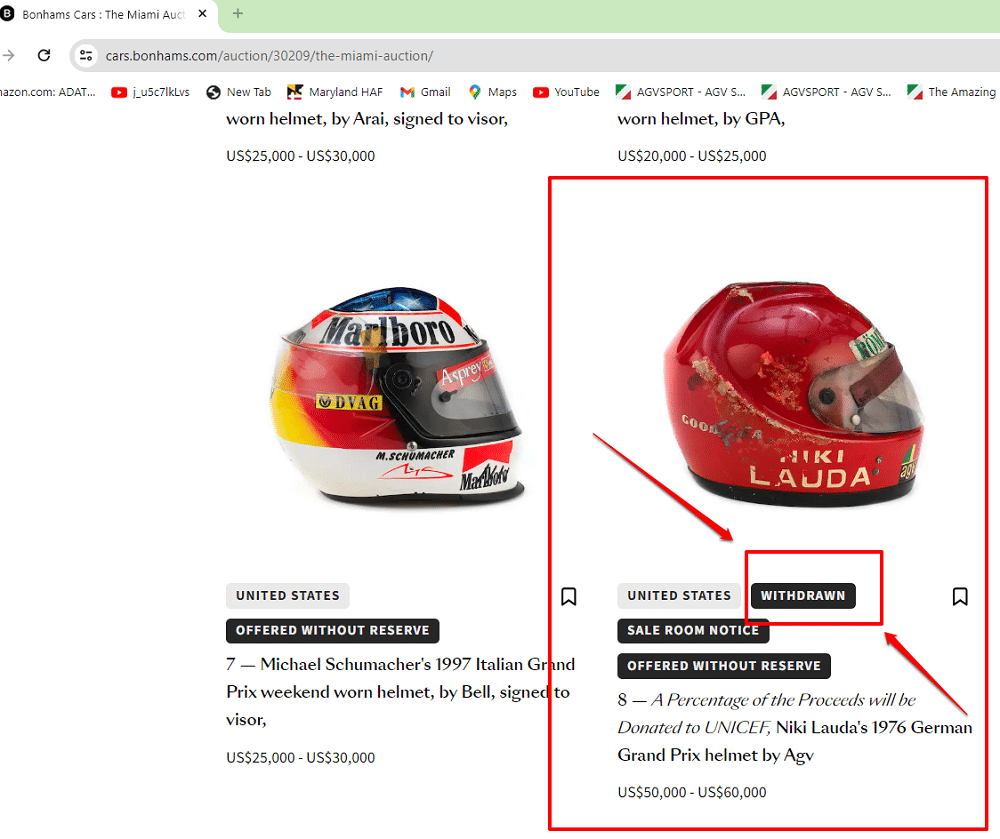
According to sources close to the situation, I’ve since learned that the withdrawal was prompted by legal considerations and concerns raised by stakeholders involved in the helmet’s ownership history. With the helmet’s tangled past and the complexities surrounding its ownership rights, organizers deemed it prudent to remove it from auction until the legal matters are resolved.
And as someone with extensive personal knowledge of this Lauda AGV X1’s storied history, I’ve dedicated significant time researching its manufacturing background, its involvement in the Niki Lauda crash, and its mysterious journey from my own office to the present moment. My longtime friend Fabio Frattini has been instrumental in uncovering some of the most confidential and previously undisclosed details. Yet, amidst the intrigue surrounding its reappearance, one lingering question persists: Was it stolen, lost, or simply misplaced? But first…
Unveiling the ‘Fitti’
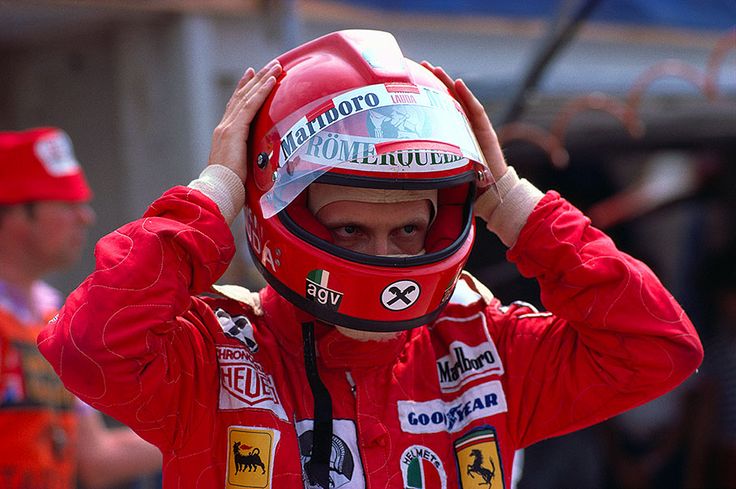
The iconic crash helmet worn by Niki Lauda in the harrowing 1976 Nürburgring crash bore the official designation of the ‘X1 Air System.’ But within the halls of AGV, it was affectionately referred to it as ‘Fitti,’ owing to the fact the illustrious Emerson Fittipaldi was the first driver to wear it, securing two Formula One World Drivers’ Championships in 1972 and 1974 while racing with the McLaren M23.
The AGV X1 Air System represented a departure from traditional helmet design methodologies. Unlike its predecessors, this innovative model featured a distinctive shell shape, characterized by an air induction intake port situated atop the helmet. In fact, it was not the product of a typical helmet designer; rather, it was the brainchild of Ennio Guazzo, a subcontractor for AGV hailing from Valmacca, an picturesque town nestled near Valenza in the picturesque Po region of Italy, in close proximity to AGV headquarters. Guazzo tailored the X1 precisely to meet the specific demands of Formula One drivers.
The process involved hand-molding the shells by Porotti in Casale Monferrato, utilizing fiberglass molds. And each shell’s outline underwent precise marking using a pencil and a jig, with the cutting process executed entirely by hand. The manual approach accounts for the observed variations in shell shapes, lending each helmet a unique identity and adding to their allure on the Formula One circuit.
The Enigma of the Decision to Auction

But why auction such a treasured artifact? You see, AGV—now under the ownership of Dainese since 2007—the powerhouse behind some of the most iconic racing helmets in history, has always held their collection close to their heart, preserving them as cherished relics of times gone by. So, why in the world would they suddenly decide to part ways with one of their prized possessions? Especially when it’s none other than Niki Lauda’s crash helmet, forever linked to his unforgettable Nürburgring accident 48 years ago. It almost feels like parting with a piece of their own soul. But, the truth is, Dainese/AGV was not involved in initiating or orchestrating the auction for this helmet.
In light of Dainese/AGV’s apparent absence from the auction proceedings, the question arises: who was Bonhams acting on behalf of in auctioning the helmet? And let’s talk numbers for a second. Sure, $60,000 sounds like a pretty penny, but when you consider the absurd amounts folks shell out for Hollywood memorabilia (ranging from hundreds of thousands to millions of dollars), it seems like an extremely low figure.
I mean, this isn’t just any old helmet — it’s Niki Lauda’s 1976 German Grand Prix crash helmet, a poignant relic of Formula One’s history and a symbol of dedication, perseverance, and bravery that inspired 2013 Ron Howard’s Hollywood film “Rush“. And to Niki’s friends and family, this helmet embodies a somber chapter in F1 racing history.

Reflecting on my more 50 years of experience working with AGV and AGV Sports Group, I’m reminded of the sponsorships contracts inked with race car drivers and motorcycle riders, explicitly outlining that the helmets remained AGV’s property and were to be returned to the company post-crash. So, what is the real story here? Who’s behind this surprising auction? And what’s their connection?
Which Helmet Standard Is The Best? Snell, DOT, ECE, SHARP, Or FIM? We Rate All 5
As I pondered these perplexing questions, memories from decades past flooded my mind. I couldn’t help but recall a momentous event in 1986, just a little over a decade after the fateful crash, when I made a request to AGV. I asked them to send the crashed helmet worn by Niki Lauda, along with helmets from racing legends Giacomo Agostini (X-3000) and Barry Sheene (X-80), to the US for a major motorcycle industry exposition in February 1987, held in Cincinnati, Ohio. Serving as the vice president of AGV Helmets’ US operations, I often had access to original historic AGV helmets, yet the Niki Lauda helmet was truly exceptional.
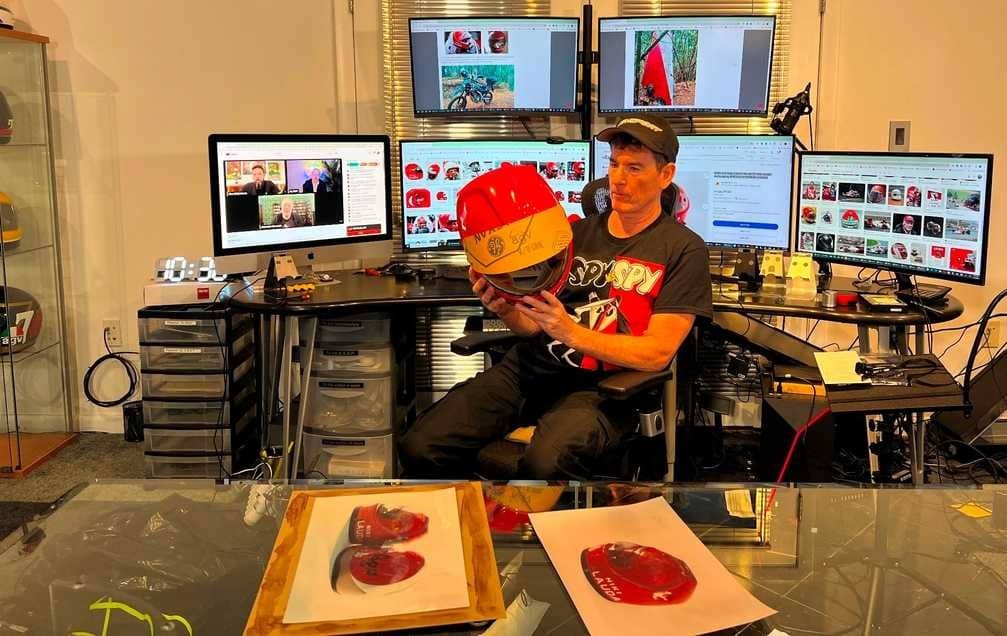
Following the exposition, I proposed to Dr. Sergio Puppo, AGV’s Managing Director, that we retain these helmets for safekeeping until their next international display. Even back then, I harbored concerns about their fate, knowing that eventually, I would have to ship them out of the United States when AGV deemed them necessary elsewhere.
Determined to capture the essence of this historic moment, I hired the expertise of professional photographer to immortalize the occasion. The resulting snapshots, now included in this article, serve as a poignant reminder of that unforgettable day.
And after the expo drew to a close, the three helmets found a new home in the glass cases in the joint offices of AGV USA/AGV Sports Group. At the time, both companies operated from the same address, sharing the same phone numbers, personnel, and the same passion for all things racing.
Unraveling the Mystery: From Frederick, Maryland, to Japan, to Milan, Back to Japan, and Finally to Miami
Subsequently, AGV Italy reached out, requesting that I dispatch the helmets to Japan for another prestigious exposition. The last time I saw the Niki Lauda’s crash helmet was when packing it for shipping. Little did I know that it would vanish into thin air under very mysterious circumstances, leaving behind a trail of unanswered questions and speculation that have lasted 37 years!
It wasn’t until a year later, in 1988, that I received word from Dr. Puppo, informing me of the unfortunate theft or disappearance of the helmet following its display at an exposition.
For years, I operated under the assumption that the incident occurred during the exposition in Japan. But recent revelations by my good friend Fabio Frattini have shed light on the true location of the helmet’s disappearance — a subsequent show in Milan, Italy. The details of the delivery of the helmet by Fabio to the expo, the show, and the disappearance only add to the intrigue surrounding this enigmatic chapter in the helmet’s storied history.
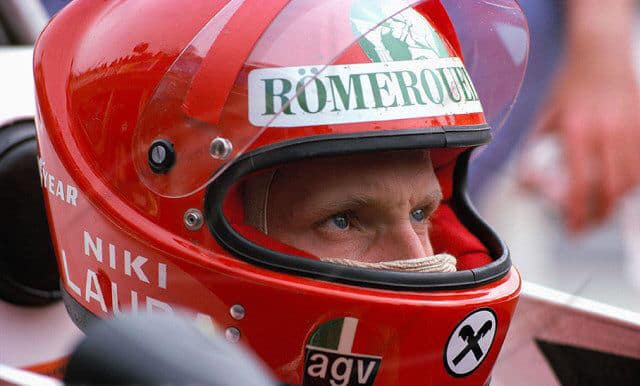
Now, here we were, on the cusp of a historic auction, and the helmet has resurfaced in the most unexpected of places — the Bonhams Cars preview tent at the Miami International Autodrome. Yes, it’s a sight to behold, a symbol of Lauda’s courage and resilience in the face of adversity, yet shrouded in mystery and intrigue!
But the plot thickens. Flashing back to 1987, following a famous Brazilian racing driver’s triumphant win of the World Drivers’ Championship, adding to his already impressive tally of two previous championships in the early ’80s, he took center stage as the “sponsor” of the Milano Car Racing Exhibition. An event, aimed at rivaling the renowned Bologna Motor Show, that promised excitement and glamour in equal measure.
During the festivities, he seized the opportunity to showcase an impressive collection of racing helmets. These weren’t just any helmets; they were displayed in a magnificent glass exhibit crafted by the esteemed Saint-Gobain Glass company. And to elevate the spectacle even further, he extended an invitation to Amisano Gino, the visionary founder and then-owner of AGV Helmets, to contribute to the showcase with none other than Niki Lauda’s iconic crash helmet.
Responding to Mr. Amisano’s request, Fabio Frattini, AGV’s Chief Technical Manager responsible for motorcycle racers and F1 drivers, and my esteemed colleague of four decades during my tenure as AGV helmets importer for the United States, took charge of the mission. With Mr. Amisano’s guidance, Fabio personally escorted the revered helmet to Milan, where it took its rightful place in the grand display, capturing the attention of all who beheld it.
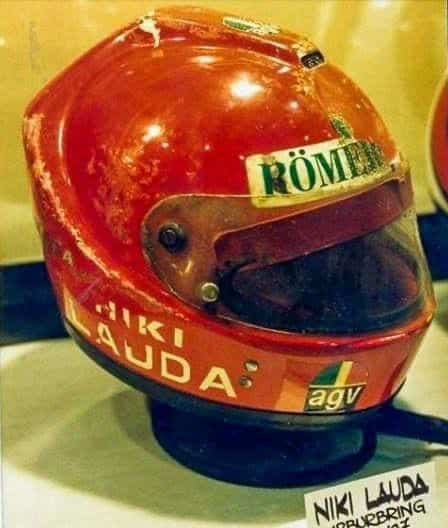
Shockingly, amidst the glitz and glamour of the evening after the show had closed, the helmet vanished without a trace, leaving the show organizers without any answers and AGV officials quite upset, especially Mr. Amisano. Was it handed over to someone unaware of its true historical value, gifted to a friend or family member who understood its significance, or perhaps pilfered by a stranger in the night? Regardless of the specifics, one thing is certain: it was taken from the case, and the perpetrator likely knew it was a questionable transaction, which is why it remained hidden for 37 years until the 2024 Bonhams’ public auction.
In the aftermath of this baffling incident, Amisano Gino, the esteemed owner of AGV Helmets, was understandably incensed by the loss. With determination bordering on anger, he initiated a formal police investigation in an effort to try and recover the helmet. He even pursued legal action against the Brazilian racing driver, holding him accountable for the disappearance. But the situation took a twist when the former Champion’s entourage shifted the blame onto a junior member, deflecting responsibility from the racing champ himself.
Despite Mr. Amisano’s fervent efforts, justice remained elusive. The compensation offered for the helmet’s disappearance paled in comparison to its true value, leaving a bitter taste in the mouths of those involved. It was a frustrating outcome for AGV and Mr. Amisano, who had hoped to see the helmet returned to its rightful place, but instead found himself mired in legal wrangling and disappointment.
As the years passed, whispers of the helmet’s whereabouts circulated worldwide. Persistent rumors suggested it was held by an affluent Japanese collector, but its true fate remained a mystery. That is, until now. With the helmet’s sudden reappearance, questions arise about its journey from Frederick, Maryland, to Japan, then Milan, and finally to Miami, prompting curiosity about the individuals who handled it during its journey.
Unfortunately, Mr. Amisano passed away back in 2009 without ever knowing the fate of AGV’s prized Niki Lauda X1 crash helmet from the 1976 Nürburgring Grand Prix.
List of All the F1 Drivers Who Wore AGV Helmets
|
Driver |
Year |
AGV Helmet Model |
Car/Team |
|
Alan Jones |
75-76 |
X80 |
Williams |
|
Alex Caffi |
87 |
X999 F1 |
Osella F1 Alfa Romeo |
|
Alex Caffi |
88 |
X999 F1 |
Benetton B187 Ford (Tester) |
|
Alex Caffi |
89 |
X999 F1 |
Dallara 3087 – F188 Ford |
|
Alex Caffi |
90 |
X999 F1 |
BMS Dallara F189 Ford |
|
Alex Ribeiro |
77 |
X1 |
March 761 B Ford |
|
Andrea de Cesaris |
1980 |
X80 |
Alfa Romeo 179 |
|
Andrea de Cesaris |
1981 |
X80 |
McLaren M29F/MP4/1 |
|
Andrea de Cesaris |
1982 |
X 80 |
Alfa Romeo 182 |
|
Andrea de Cesaris |
1983 |
X80 |
Alfa Romeo 183T |
|
Andrea de Cesaris |
84 |
X80 |
Lijer JS23 Renault |
|
Andrea de Cesaris |
88 |
X999 F1 |
Rial ARC1 Ford |
|
Andrea de Cesaris |
89 |
X999F1 |
BMS Dallara FV189 Ford |
|
Brian Henton |
1975 |
X80 |
Lotus 72 |
|
Bruno Giacomelli |
77 |
X80 |
Mc Laren M23 Ford |
|
Bruno Giacomelli |
78 |
X80 |
Mc Laren M26 Ford |
|
Bruno Giacomelli |
79 |
X80 |
Alfa Romeo 177 |
|
Bruno Giacomelli |
80 |
X80 |
Alfa Romeo 179B |
|
Bruno Giacomelli |
81 |
X80 |
Alfa Romeo 179C |
|
Bruno Giacomelli |
82 |
X80 |
Alfa Romeo 182 |
|
Bruno Giacomelli |
83 |
X80 |
Toleman TG 183B Hart/Ferrari £12 T4 (Test) |
|
Capelli |
88 |
X999 F 1 |
March 881 Judd |
|
Capelli |
89 |
X999 F 1 |
March 881 Judd |
|
Emerson Fittipaldi |
73 |
X80 |
Lotus 72D |
|
Emerson Fittipaldi |
74 |
X1 |
Mc Laren M23 |
|
Emerson Fittipaldi |
75 |
X1 |
Mc Laren M 23 |
|
Emerson Fittipaldi |
76 |
X1 |
Copersucar 03 |
|
Emerson Fittipaldi |
77 |
X1 |
Copersucar 04 |
|
Emilio De Villota |
76 |
X1 |
Brabham BT 44B Ford |
|
Enrico Bertaggia |
89 |
X999 F1 |
Coloni C3 Ford |
|
Enrico Bertaggia |
92 |
X999 F1 |
Coloni C4 Ford |
|
Ian Ashley |
1977 |
X1 |
Hasket 308 Ford |
|
Ingo Hoffman |
1976 |
X1 |
Copersucar FD03-04 Ford |
|
Ingo Hoffman |
1977 |
X1 |
Copersucar FD03-04 Ford |
|
Larini |
1987 |
X999 F1 |
Coloni FC 187 Ford |
|
Larini |
1988 |
X999 F1 |
Osella FA1 L Alfa Romeo |
|
Larini |
1989 |
X999F1 |
Osella FA1 M Ford |
|
Lella Lombardi |
74 |
X80 |
Brabham BT 42 |
|
Lella Lombardi |
75 |
X1 |
March 741 751/Williams FW04 |
|
Lella Lombardi |
76 |
X1 |
Brabham BT 44B, March 761 |
|
Nelson Piquet |
87 |
X999 F1 |
Williams FW 11B – Honda |
|
Nelson Piquet |
88 |
X999 F1 |
Lotus 100 T- Honda |
|
Niki Lauda |
76 |
X1 |
Ferrari |
|
Niki Lauda |
75 |
X80 |
Ferrari 312T |
|
Oscar Larrauri |
1988 |
X999F1 |
Eurobrun ER 188 Ford |
|
Oscar Larrauri |
1989 |
X999F1 |
Eurobrun ER891 Judd |
|
P. Carlo Ghinzani |
84 |
X80 |
Osella FA1F Alfa |
|
P. Carlo Ghinzani |
85 |
X80 |
Tolleman TG 185 Hart |
|
P. Carlo Ghinzani |
86 |
X80 |
Osella FA1 F Alfa Romeo |
|
Riccardo Patrese |
76 |
X80 |
Shadow DN8A Ford |
|
Ronnie Peterson |
75 – 78 |
X80 |
March/Tyrell/Lotus |
|
Vittorio Brambilla |
75 |
X80 |
March 741 Ford |
|
Vittorio Brambilla |
76 |
X1 |
March 761 Ford |
The Intriguing Past and Legal Battles
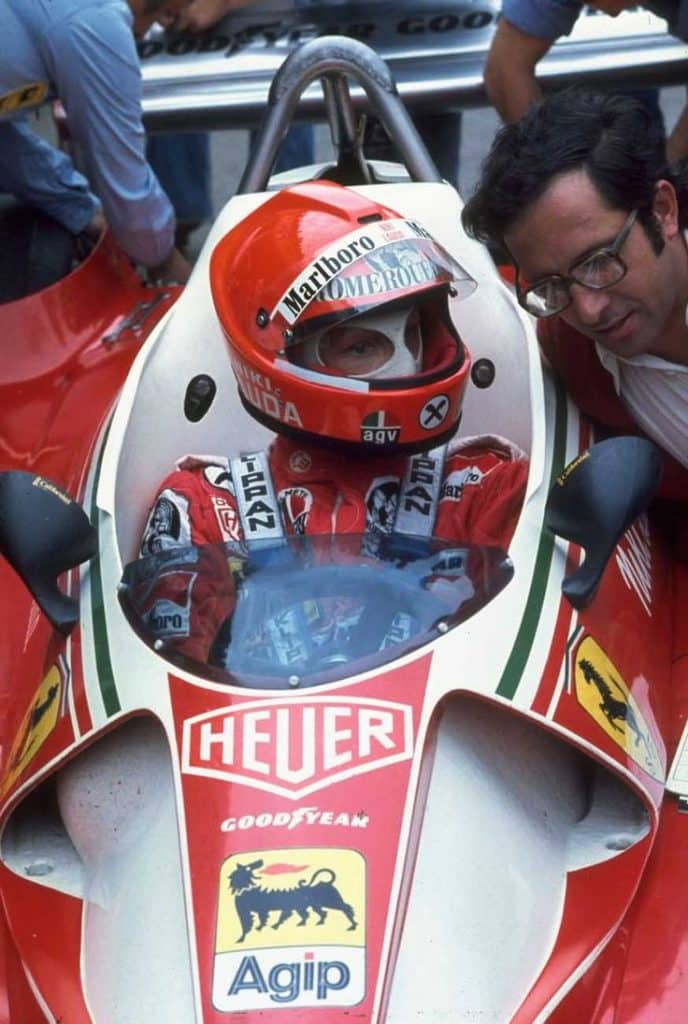
As fate would have it, the helmet made a swift getaway from Milan to Japan, where it found itself in the hands of eager collectors. Over the years, it changed ownership four or five times, passing from one Japanese F1 enthusiast to another like a prized relic shrouded in secrecy. With each new custodian, the helmet’s mystique only grew, its storied past whispered about in hushed tones among racing aficionados.
Then, five years ago, the last owner passed away, leaving the helmet in the hands of his family. Probably unaware of the treasure they possessed, they made the fateful decision to transport it to Miami for an auction – little did they know, they were unwittingly thrusting themselves into the spotlight of one of racing’s greatest mysteries.
Now, with the Niki Lauda’s AGV X1 crash helmet withdrawn for the auction at the Bonhams|Cars Exclusive Auction Of Collector Cars and Helmets Event during the 2024 Miami Grand Prix event, it casts a spellbinding charm over the spectators, drawing them into its enigmatic aura. But behind the scenes, its true significance remains shrouded in secrecy, known only to those privy to its clandestine past.
Upon learning of its public auction, I immediately reached out to my longtime friend, Fabio Frattini, who served as the Chief Technical Manager at AGV for over 20 years. With his intimate knowledge of the company’s history and operations, I knew he would be an invaluable resource in unraveling the mystery surrounding the helmet.
True to form, Fabio took action, having been in contact with Dainese, the company that acquired AGV from Amisano Gino in 2007, two years prior to Amisano Gino’s passing. And with their combined efforts, they have unearthed the original legal documents pertaining to the loss of helmet, filed away by Amisano himself many years ago. Interestingly, even the Brazilian racing driver’s “manager,” the individual purportedly responsible for the disappearance of the helmet, is still alive!
But rumors abound regarding potential claims to ownership, including from the Lauda family. While understandable, given the familial connection to the legendary racer, it’s likely that they are unaware of the contractual agreement between AGV and Niki Lauda. The agreement explicitly stated that the helmet remained the property of AGV, adding another layer of complexity to the unfolding drama.
And so, I find myself at a crossroads once again, grappling with the implications of the helmet’s withdrawal from auction, raising questions about its future and the resolution of the legal issues surrounding its ownership. Will the helmet resurface for auction in the future, find its way back to Dainese/AGV’s collection, reunite with Niki Lauda’s family, return to the family of its 4th Japanese buyer, or will it remain veiled in mystery indefinitely? Only time will reveal the outcome as the saga of Niki Lauda’s iconic AGV X1 crash helmet continues to evolve.
The Enduring Legacy of Niki Lauda
Yet, amidst the uncertainty and intrigue, one thing remains abundantly clear: the enduring legacy of Niki Lauda and the profound impact he had on the world of motorsports. His courage, determination, and unwavering spirit continue to inspire generations of racing enthusiasts, reminding us of the power of perseverance in the face of adversity.
As I reflect on the twists and turns of this captivating saga, I can’t help but feel a sense of awe and wonder at the mysteries that surround us. From the heights of triumph to the depths of uncertainty, the story of Niki Lauda’s legendary crash helmet serves as a poignant reminder of the indomitable human spirit and the enduring allure of the racing world.
And let’s not forget — Niki’s courage wasn’t confined to the racetrack. Years later, he waged another battle, this time against Boeing after the tragic crash of Lauda Air 004 in May 1991. Flight 004, a 6-month-old Boeing 767 en route from Don Muang Airport in Bangkok, Thailand, to Vienna, Austria, ended in disaster. It marked the world’s first crash involving a Boeing 767, claiming the lives of all 223 people on board and standing as the deadliest aviation incident in Thailand’s history.
Lauda’s steadfast conviction that the crash resulted from a design flaw causing the uncommanded deployment of the left-engine thrust reversers, rather than pilot error, proved pivotal. His relentless pursuit of truth in the accident investigation led to significant global changes in aircraft engine design, undoubtedly saving countless lives.
You can watch more videos on our YouTube Channel:
Why Did Niki Lauda’s Helmet Come Off in 1976 Nürburgring Germany Crash?
The AGV X1 Air System F1 Car Racing helmet was produced in one shell size with two different Expanded Polystyrene liner sizes. Unlike today most helmets from this era were only manufactured with one shell size. Since there was only one shell size and two liner sizes, all the different sizes of the helmets for the drivers were obtained by adjusting the comfort padding within the helmet. Lauda had a small head and therefore had a lot of padding. The chin strap of the X1 (like all helmets in that period) was mounted in a more forward position than today’s helmets because it was more comfortable for the driver.
With the chinstrap mounting closer to the front of the helmet the comfort padding compressed enough for the chinstrap to come off his chin when the helmet was slammed into the headrest. The roll-off test method to verify that the helmet does not “roll off” the head had not yet been invented and introduced about arrive 10 years later. With a very violent impact the helmet came off Niki Lauda’s head without any damage or elongation of the chin strap.
In fact, the helmet itself did not suffer any serious impact damage, and the shell and liner were intact. In the mid-1980’s, there was a motorcycle race where one rider struck three others from behind at a high rate of speed. Three of the riders lost their helmets due to roll-off problem, and they were all wearing different brands of helmets. After this time period, chin strap positioning was moved rearward, and most international helmet standard’s and tests began to incorporate roll off tests into their requirements for certification.
An interesting post on Reddit that I saw: “It actually stayed on his head after the first impact, which is why it was burned, the second impact with Brett Lunger is what caused the helmet to come off. Lunger jumped out of his car and helped Mezario pull Lauda out. The Lauda helmet, and the Senna helmet, were both altered by the drivers. Lauda preferred a loose-fitting helmet and Senna used a helmet with a thinned shell for lower weight and strain on his neck. Driver’s helmets today are all certified to very stringent car racing helmet standards”
Rare AGV X1 Helmet Worn By Niki Lauda In Infamous 1976 Crash Hits Auction Block, Expected To Fetch Up To $60,000
Ron Howard’s Movie Rush Is Based on Niki Lauda’s Story:
Official Trailer: https://www.youtube.com/watch?v=4XA73ni9eVs
Read More About Niki Lauda’s Flight Crash Here: https://agvsport.com/blog/travel/long-ride-horror-of-lauda-air-plane-crash-site-in-thailand.html
For more information about safety helmet standards please read this article:
Information for this article was partially sourced and researched from the following authoritative government, educational, corporate, and nonprofit organizations:
- Niki Lauda
- The Amazing History Of AGV Helmets And Gino Amisano
- Dainese: When AGV & Lauda Conquered the World
M/A













